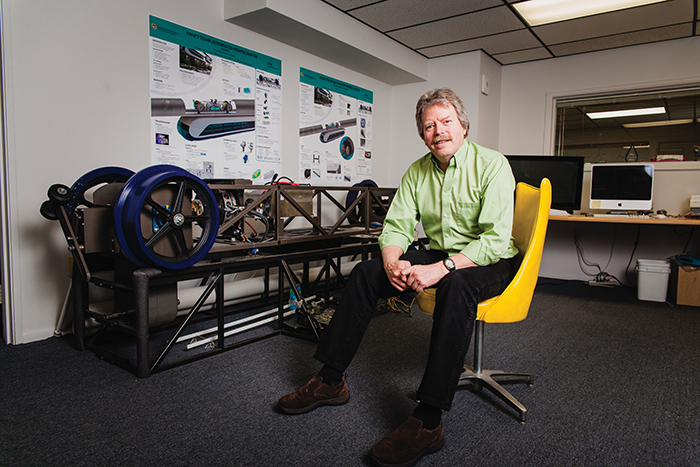Swift Tram: The future of automatic transit?
Carl Lawrence explores a high-tech solution to a Colorado transportation problem
Eric Peterson //March 28, 2016//


Swift Tram: The future of automatic transit?
Carl Lawrence explores a high-tech solution to a Colorado transportation problem
Eric Peterson //March 28, 2016//
Swift Tram / where: Boulder / web: www.swifttram.com / Founded: 2011
Initial Lightbulb:
One of the minds behind the original buses on Denver’s 16th Street Mall, Chairman and Chief Technology Officer Carl Lawrence started Swift Tram as a response to FasTracks’ budget troubles five years back. “They were cutting back on light-rail plans, especially in Boulder and the northern area, and cutting back on buses,” he says.
Developed more than a century ago, suspended coaches seemed like an overlooked answer to Lawrence. Only in use at a few locations in Germany, automated suspended coaches carry 75,000 people a day in some locations. Lawrence compares that with 55,000 daily riders on the 16th Street Mall buses.
So he started the company and has since recruited a team of eight people to guide the development of a next-generation “automatic transit network.”
In a Nutshell:
Swift Tram’s system features suspended coaches that leverage software for efficiency and could ultimately be operated for one-third the cost of buses, moving 5,000 riders an hour with solar energy. The design calls for coaches suspended 20 feet above the ground running on an elevated fixed guideway.
The first step: building a 1,500- to 2,000-foot demo system to prove the concept. “We’re looking at several places around the Denver metro area,” says Lawrence.
The price tag “is a lot less than the cost of light rail or commuter rail,” says Lawrence, and it’s possible to interconnect and expand systems as they are built.
The ultimate vision is an “automated transit network” with stations spaced two to four miles apart. “It would be faster than you could ever go by car,” says Lawrence, projecting a first-generation coach that could carry 25 people at 35 miles per hour. Faster regional systems would max out at about 125 miles per hour.
Lawrence sees the technology as a possible salve for one of Colorado’s worst transportation ills. “A couple years ago, we responded to a request for information from CDOT for the I-70 corridor,” says Lawrence, describing a coach system running from Denver to Vail. “Technically, it’s all doable,” he says. The billion-dollar question: “Do you go through the tunnels or go over the top?”
But the numbers don’t necessarily work out. “During the week, you’d lose money,” says Lawrence, calling I-25 “more lucrative” for a suspended coach system.
The company is targeting much smaller projects. “We’re pacing ourselves,” he says. “We’re looking for small, easy projects to start with.”
Swift Tram is in the process of forming partnerships with various companies and organizations that could help build coach systems.
The Market:
“There are a half-dozen ways to pay for a system like this,” says Lawrence, citing public-private partnerships and site-specific “transit as a service” as possible models.
The market “will evolve,” he adds. “The low-hanging fruit is pretty much where you see shuttle buses used today. That’s the early market. Later on, it competes with light rail and commuter rail.”
Financing:
“Right now, we’re using angel investor money to fund development work,” Lawrence says.

























